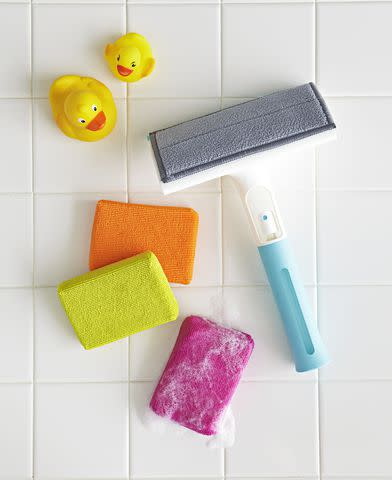6 Mistakes to Avoid When Cleaning Your Shower
These cleaning techniques can leave your tile shower less than sparkling.
:max_bytes(150000):strip_icc():format(jpeg)/102178792_preview-75894188dcb64e7e9dacb9fbe5b6bfb6.jpg)
Lincoln Barbour
OK, this is embarrassing. I’ve been a Better Homes & Gardens editor for many years, and I recently found myself with a mess in my once beautiful tile shower.
When I moved in five years ago, the shower was dazzling: white subway tile walls, light-gray penny tile floors, pristine white grout, and clear glass doors. But over the years, it got really yucky. (I was cleaning it regularly, I swear!) It seemed like no matter which product or brush I used or how hard I scrubbed, I couldn't get rid of the grout discoloration. I knew I needed professional help.
Enter Blake Wernimont of Grout Works. In about half a day, Blake performed his shower restoration service, a deep clean using special chemicals, brushes, and a whole lot of elbow grease. He cut out all the existing caulk with a razor blade, applied new caulk, then resealed all the grout with an acrylic sealer specially formulated for grout.
But the best thing Blake did was point out mistakes I was making in cleaning and maintaining my shower. These mishaps were making it harder to clean and easier for mold, mildew, and other grossness to go unchecked. Here's what I was doing wrong.
1. Using Bar Soap
Thinking I was doing a good thing for the environment and my budget, I had switched to bar soap (it’s cheaper and no plastic bottles). However, bar soap has oil in it that mixes with the minerals in hard water to form an especially stubborn soap scum. Yes, you can still get soap scum from shampoo and body wash, but it’s not as bad as that left from bar soap. And the longer you allow soap scum to remain in place, the harder it is to remove. Left to its own devices, soap scum can even begin to grow mold.
If you’re a bar soap user and find yourself with a soap scum problem, Blake recommends Dawn dish soap. It breaks down the grease that soap scum sticks to. Put a couple drops of Dawn in a bucket of warm water, scrub with a washcloth, then rinse and dry.
Related: How to Clean a Shower So It Sparkles from Top to Bottom

2. Leaving Water on Glass Doors and Tile Walls
For years, I let my shower air dry, occasionally leaving the door open for better airflow. I’d heard of people squeegeeing glass shower doors, but I thought that was more for looks than cleanliness. Turns out, it's crucial to dry up all that water, including on walls, glass doors, and the floor, every time you shower. If you don’t, over time, you’ll end up with water-spotted, filmy glass and, worse yet, moldy grout.
3. Ignoring the Floor
Shower floors are built with a gentle slope that is supposed to lead water to the drain. However, the slope in my shower wasn’t quite steep enough for gravity to do its thing. Plus, over the years, our feet had been making divots where water was pooling.
While you don’t have to get shower floors perfectly dry, you do need to move any standing water down the drain with a squeegee. So, until somebody invents a self-drying shower (how far off can that be, really?), build a few extra minutes into your routine to dry all the shower surfaces, every time you bathe. You can use a towel or a squeegee (I like this one from IKEA because it looks nice; I call it the “executive squeegee.”); no matter which product you choose, take the time to dry every surface.
4. Forgetting to Run the Fan
No doubt your bathroom has an exhaust fan. It’s not just for de-funkifying the air after somebody uses the facilities; it's also for pulling moisture out of the air, helping your shower dry more quickly so you can avoid mold problems. “A shower is made to be wet, but the more moisture you can keep out of there the better off you are,” Blake says. He suggests running the fan both during your shower and immediately after it, for 30 minutes in the winter and an hour in the summer.
If your fan doesn’t already have a timer, Blake recommends having one installed. A timer replaces the on-off switch with either a dial (kind of like the one on the warming light in a hotel bathroom) or buttons so you can choose how long you want the fan to run before it automatically shuts off. They cost about $25 to $50 and can be installed by an electrician pretty easily (or as a DIY if you're handy). Be sure to choose an option that offers at least a one-hour setting.
Do not leave your bathroom fan on longer than an hour or all the time. Doing so is a waste of energy and a potential fire hazard. Instead, use a timer, and don’t forget to start the timer when you step out of the shower.
While we're talking fans, not all are created equal. To rid the air of moisture, you need to make sure yours has a high enough CFM (cubic feet per minute) rating. This refers to the amount of air the fan moves. An easy way to test whether your fan is powerful enough it to turn it on and put a Kleenex up to it. If the tissue sticks to the fan, your model has an effective airflow.
Related: The 7 Best Bathroom Exhaust Fans of 2024 to Eliminate Mold and Odor
5. Skipping a Weekly Sanitization
Turns out, my shower's mold problem wasn't (entirely) my fault. My metro area has some kind of fungus in the water that turns things orange or pink. Nice, right? Blake recommended stopping that stuff in its tracks with good old-fashioned bleach. I now keep a spray bottle with a very weak water-bleach solution (1 part bleach to 10 parts water) in my shower. Once a week, after a shower, I spray all the wet surfaces with this solution and let it sit for about 20 minutes. Then I rinse with water and dry it as usual. Blake says that should cut down on any mold growth and so far, so good.
Make sure to turn on your bathroom fan for this entire process to clear the fumes.

Annie Schlechter
6. Not Treating the Glass
Glass shower walls and doors look awesome, but if you don’t keep them clean and dry, they get spotted, streaky, and covered in a film. This is a problem particularly if you have hard water. Hard water can etch glass, and once that happens, you'll likely need a pro to remove it without scratching the glass. So, short of switching to soft water, you need to be extra diligent about keeping the glass clean and clear. Luckily, Blake knows a secret weapon: Rain-X.
Rain-X is a water repellant originally used on car windshields. Now there are formulas meant for treating shower doors. You spray it on, wait a few minutes, then squeegee or wipe it off. It makes the water bead up and slide right off the glass, rather than staying put, drying in place, and making water spots. As Jet Dry is to your dishwasher, Rain-X is to your shower. Non-spotty glasses; non-spotty glass doors.
A Rain-X treatment is totally worth the time (about half an hour) and money (about $10). However, this stuff does off-gas quite a bit, so you’ll want to turn on the fan, open a window, and even wear a mask. And you will need to reapply the Rain-X every three or four months, or once you notice the water is staying put rather than rushing down the door.
Before you apply Rain-X to your glass doors, get them as clean as you possibly can. Again, Blake likes Dawn for this job. Put a few drops of Dawn in a bucket of warm water and use it to wipe the doors vigorously, on both sides, with a soft sponge or a soft cloth. No brushes—you don't want to risk scratching the glass. Dry the doors with paper towels or a soft towel. Then, and only then, Rain-X ‘em!
Tips for Maintaining a Clean Shower
Instant Payoff
Are you storing shampoo and body wash bottles on the ledge of your shower or the floor? Bad idea, unless you enjoy moving them every time you bathe so you can dry under them. Instead, get yourself one of these triple-decker shower storage shelves for just $8(!) from IKEA. It tucks neatly into a corner, stores a lot of stuff, including your bleach water and squeegee, and is easy to move out of the way when it’s time to dry the walls and floor. This has been a game-changer at my house.
For the Future
If you ever remodel your bathroom, go for large-format tile, whether ceramic or porcelain, on the walls. Tile comes as large as 2 feet by 4 feet and can be used on both walls and floors. With tiles this large, there is a lot less visible grout, which means fewer opportunities for mold and mildew to rear their ugly orange heads. Plus, large-format tile looks sleek and modern. Bonus points if you use dark grout, which won’t show discoloration as much should you get a little mold or mildew going (which of course you won’t, after reading this).
For the floor, Blake’s pick for easy maintenance is cultured marble. It’s a manmade solid surface, kind of like quartz. It can be poured in a single panel, so there are no grout lines.
For more Better Homes & Gardens news, make sure to sign up for our newsletter!
Read the original article on Better Homes & Gardens.

